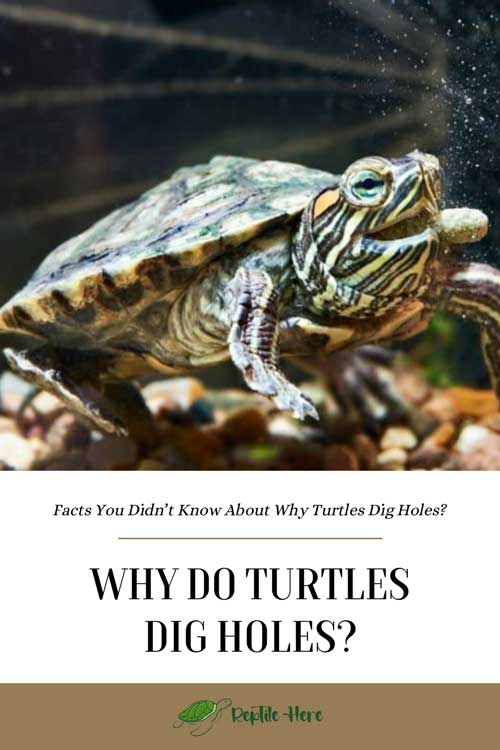Why Do Turtles Dig Holes? Facts You Didn’t Know About Why Turtles Dig Holes?
So you have lately noticed your turtle digging holes? If you’re a new pet owner and don’t know much about turtle behavior, this might have caught you by surprise. And you may have wondered what causes them to do it.
Why do turtles dig holes? Turtles dig holes to prepare to lay eggs or hibernate. Sometimes they may also dig holes for other reasons such as to forage for food such as shrimps, bugs, insects, etc., or for comfort and safety.
This article will dig deeper into the topic of turtles digging holes. We have discussed in more detail why turtles dig holes and hopefully help you easily tell the exact reason why your turtle is doing it.
Why do turtles dig holes?
Contents
Turtles dig holes mainly when they want to prepare a nest for laying eggs or to hibernate in the cold winter months. But there are additional reasons that might push your pet to start digging holes or burring itself in the tank, sand, or soil.

Let’s discuss the top reasons why your turtle may dog holes:
It’s time to lay eggs
One of the main reasons a turtle digs a hole is to prepare a nest for laying eggs. This is inclusive of sea turtles which will go to the shores to dig a hole as a nest. These animals will lay eggs once or twice yearly, or once every few years—depending on the species.
It is also interesting to note that when doing so, turtles go ahead and make decoy holes as well. This is a smart move to confuse the predators that may feed on their hatchlings.
The wolves and rats, for instance, can easily smell the mother turtle’s scent and start digging their way to the hatchlings.
The decoy holes buy the baby turtles more time to hatch. The turtle eggs for a red-eared slider, sea turtles, and box turtles usually take around 2-3 months to hatch.
One way to tell a decoy hole from other types of diggings is how the animal does it. If you observe the female pregnant turtle digging the holes using the hind legs, then it is most likely a decoy hole!
But the only way you can be sure is after the hole is dug and she lays her eggs. After the mother turtle is satisfied with her new hole, she’ll put her rear quarters into it and proceed to lay an egg (though it can be multiple eggs, depending on the species of turtle). Afterward, she’ll cover the hole.
Note that turtles usually lay eggs in the spring or summer. Thus, if you find your turtle digging in winter, it’s a surefire sign that it’s digging not to lay eggs but for other reasons like hibernating or looking for food.
Watch the video below of a rare and exciting moment of a turtle laying eggs.
The turtle wants to hibernate
Another reason you may have seen your pet turtle digging is to hibernate (or brumate, if you like). As you already know, turtles belong to the reptile family and are unable to warm their bodies on their own.
As such, the only way they can regulate their body temperature and survive is by digging in the mud, ground, or sand.
When the turtle’s body temperature starts dropping, their instincts tell them to start looking for ideal places to hibernate. If they don’t get a suitable hiding spot, they’ll start digging a hole for hibernation.
As this turtle hibernation report explains, when the body temperatures fall below 50 °F or 10 °C, turtles will stop feeding and become sluggish. At this point, they start looking for suitable places for brumation where they stay until the weather gets warmer.
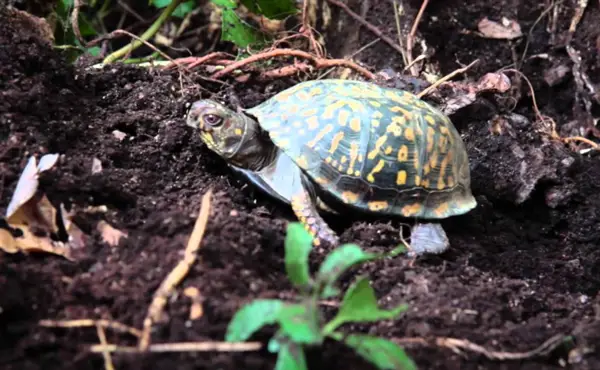
Their bodily functions such as breathing and digestion slow down as the weather becomes colder. They’ll then start moving slower as a way of conserving as much energy as possible.
With that said, if you find your turtle digging on a hot day or in the hot summer months, then it’s doing it for other reasons and not hibernation. You can use this as an elimination method to help you understand precisely why the turtle is digging.
Preparation for aestivation
For starters, aestivation in turtles refers to the summer version of hibernation. Don’t get it? Well, it is the part where the reptiles go to sleep during hot weather to try and cool off their bodies.
When the temperatures get too hot, turtles have a tendency of digging holes and hiding underneath to try and beat the heat and stay cool. This is easy to understand since these are cold-blooded animals whose temperatures change relative to their surroundings.
If you see your turtle trying to dig holes on a sunny day, then it is most likely doing so to escape the high temperatures and protect itself.
Hunting for food
Turtles will also dig into the ground to forage for food. These foods include worms, insects, bugs, shrimps, etc. Wild turtles’ diet revolves around crustaceans and aquatic insects, which are usually found between gravels in water beds.
Don’t be surprised if your captive turtle applies this to the gravel lying at the bottom of its tank.
However, this happens from time to time for pet turtles. It will mostly happen if you don’t feed your turtle enough or the right type of food. It may be left with no other option but to turn to its wild instinct—which is to dig in the soil in the hope to find food.
Wild turtles are capable of sensing worms and bugs on the earth. which leads them to scavenge the grounds for food. But they won’t waste a lot of energy in this kind of digging since the burrows are usually shallow.
Moreover, the animals are conditioned to dig in soft soils to help preserve as much energy as possible.
Thus, if you find out that your turtle is digging shallow holes, that’s a sign of lack of food and it’s simply digging to forage for food. Some turtles can even dig holes as a way of signaling you that they’re hungry in case you’ve delayed their meal timings.
Other reasons turtles dig holes include:
- For comfort and safety: Turtles may also dig simply because they want to feel more secure. This may have something to do with a poorly setup habitat, say a too shallow tank or having an open top on the ground. Or you could’ve placed the terrarium in an area with a lot of movements or visitors that make your pet frightened. If you have a box turtle, they may dig and burrow into the dirt because they feel more comfortable when down there.
- To fight boredom: Yes, your turtle could also be digging that hole because he/she is bored. However, it can be hard to tell if the animal is digging due to boredom, so you’d want to do the elimination process to arrive at this conclusion. To keep your turtle from digging due to boredom, try creating a stimulating environment to keep them entertained. Upgrading to a bigger, more spacious tank. Adding some safe plants, toys, and hideaways will also keep your dear turtle entrained.
- Your turtle wants to eat rocks: Turtles eating rocks is nothing new and many pet owners have witnessed it many times. Though there are no clear reasons why turtles, lizards, tortoises, and other reptiles do this, it is believed that they simply do so to nourish their minerals needs. This is especially true for iron and calcium deficiency. While small rocks/pebbles may not be a problem, bigger ones pose a choking hazard to your turtle and may even block their intestine! If you watch your turtle and conclude that it’s digging to eat pebbles, try supplementing their budget with nutritional supplements to see if they’ll stop this behavior.
Why is my turtle Digging in the tank?
If you have noticed your turtle getting into the unusual behavior of digging into the tank, there’s nothing to worry about. This is perfectly normal behavior and the turtle will dig if they’re curious, hungry, or just want comfort.
They could also be digging into the tank because the water inside the aquarium is too cold for them. This might trick their body into thinking it’s winter time—brumation time—and switch off to hibernation mode.
Ensuring that your water isn’t too cold by constantly monitoring its temperature will help ensure your pet turtle enjoys the optimal environment temperatures (not too cold or too warm) to get into them digging.
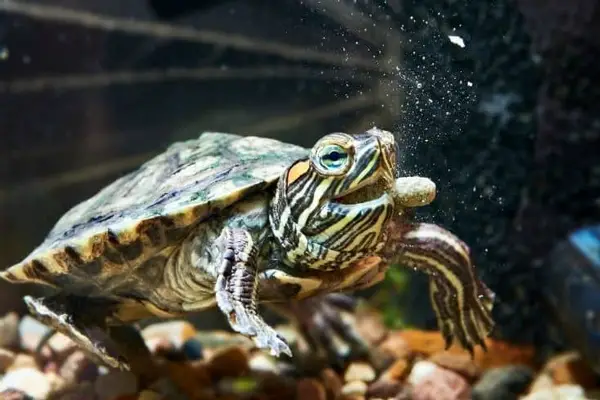
Digging into the terrarium is common for nearly all aquatic turtles, including diamond-back terrapin, and red-eared slider. It is just the same way wild aquatic turtles will go to the bottom of the lakes or ocean, and burrow themselves in the mud to hibernate or for other reasons described above.
Why is my turtle burying itself?
Not just digging holes, turtles also have a tendency of burying themselves with sand or any other substrate in the tank.
Your turtle is completely covering itself with dirt, mud, plants, or other items in the tank could be due to brumation (due to cold winter months), preparing for aestivation, to feel safer and more secure, or just to feel more comfortable.
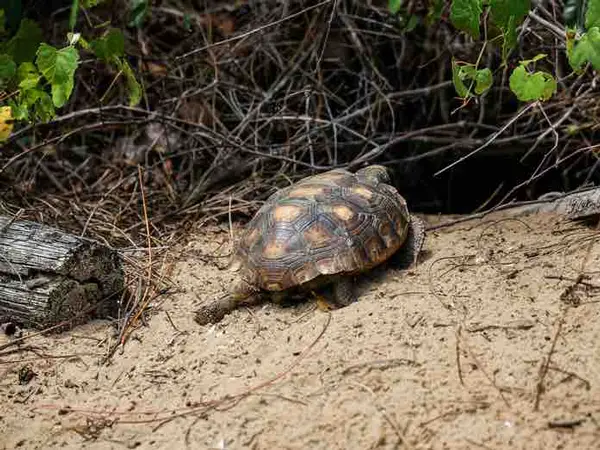
However, your turtle completely burying itself doesn’t always mean it is foraging for food or fighting boredom.
How deep do turtles dig?
Turtles can dig holes 2 to 3 feet deep into the earth. Quite deep for such a small animal, right? Turtles are excellent diggers and love digging deep into the earth.
Not just the wild ones, your captive turtle will also dig just as deep. it is just one of the things that come naturally to these reptiles.
For this reason, we recommend building your pet turtle’s habitat with sand bedding up to 2 feet high. This will ensure they have ample space to into. It will give them a fan activity to do when they want to fight boredom.
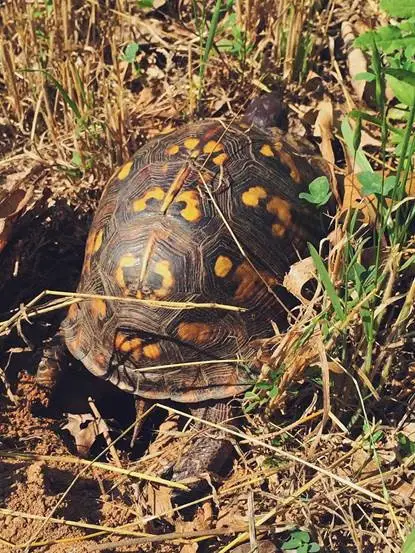
However, if you have your friend turtle’s habitat situated outdoors, you may want to strengthen the barriers at the enclosure to at least 3 to 4 feet deep into the earth.
This is a great security measure to keep these excellent diggers from creating a burrow to escape.
How long does it take for a turtle to dig a hole for eggs?
A turtle digs a hole for eggs in a day. However, there’s no specific timeframe it takes for a turtle to make the hole. This hole is usually flask-shaped and around 12cm deep.
They do this using their front and rear limbs and will complete it in one time, without stopping and coming to resume the next day.
Going by the wild turtles’ egg-laying behavior, they usually dig the hole at night, most likely to make it harder for the predators to find these turtle nests. However, they can also begin holes before the sunset.
The female may even dig several different holes during the night, only to abandon all of them and move to create a new hole.

They may continue this behavior for several nights, without completing a hole and laying any eggs until all their conditions are met (most of which aren’t well known).
After she digs the final nesting place, the turtle will spend hours covering the hole and spend the rest of her night undercover, near the nesting place. Or she may make the journey back to her home.
How can you help your turtle dig safely?
Digging is a perfectly normal activity for turtles and stopping them from doing it will simply be treating them unfairly. The only thing you can do is assist them in their digging adventures.
One way to do this is by creating a secluded mounding area for your little friend. You can simply fill an entire enclosure with dirt for them to dig into or simply select one secluded mounding area in a corner.
You can put this mounding in a shallow box or use a deeper box with stepping stones for your turtle. Ensure you use easy-to-collect and clean materials for creating the mounding to make things easy for you in the future.
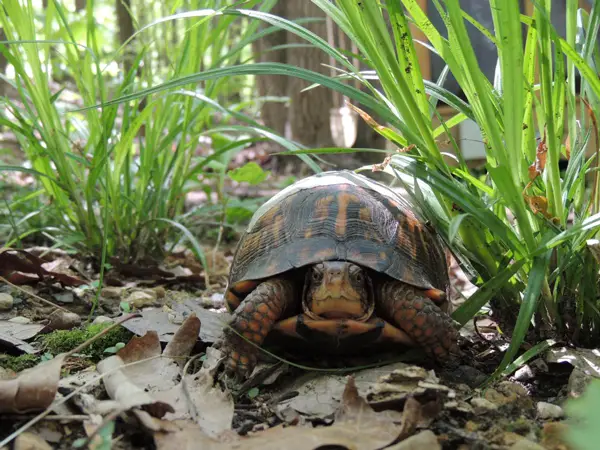
You should also create a few hides for them using dirt and soft moss. This may not give your pet a similar experience to digging dirt but will be a good way for them to pass time every day.
Above all, grant your pet turtle some outdoor time. Instead of keeping your pet inside a 4-walled container all through, take them out once in a while and place them outside in a safe area so they can explore.
Related question (FAQs):
Most species of box turtles, including extern box turtle, can dig holes as deep as 2 feet for laying eggs. However, some of them can go as deep as 3 feet. Therefore, make sure your box habitat has sand bedding that enables them to dig holes this deep.
Your male turtle is digging because he wants to hibernate or aestivate. he may also be hungry or bored. In some cases, the turtle will dig to eat rocks for reasons that aren’t clearly known. Only female turtles will dig to lay eggs, not male turtles.
Final Word
Turtles mainly dig holes to lay eggs or to brumate. Other than that, they may also dig holes to escape high temperatures in hot weather, fight boredom, hunt for food, feel more secure and comfortable, or eat rocks.
It can be hard to tell the specific reason your turtle is digging. But if you follow the cues we have given in the above guide, you can come closer to a more accurate reason.
Using the elimination process will also help you easily tell the reason for digging and make the necessary environment modifications for your turtle friend.
